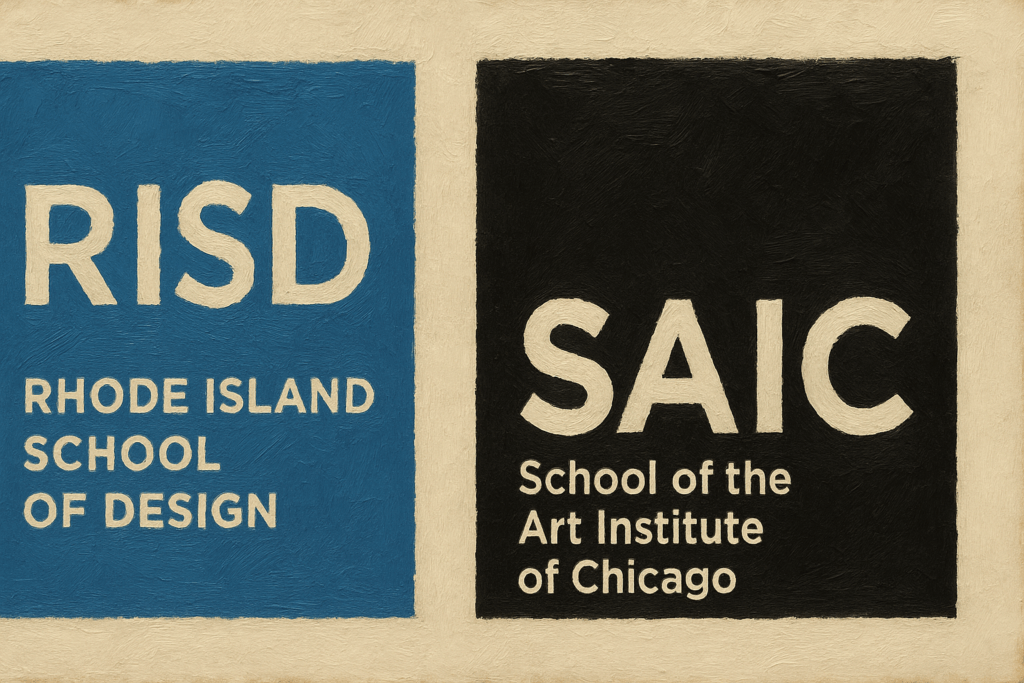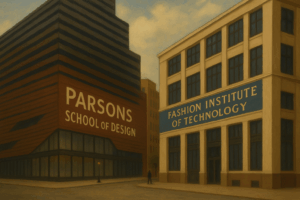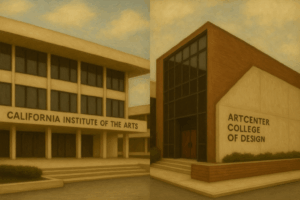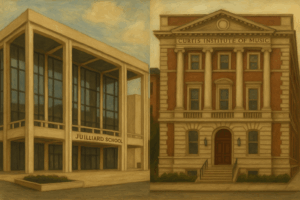
The GOAT of American Art Schools?
When discussing the best art schools in the United States, the Rhode Island School of Design (RISD) and the School of the Art Institute of Chicago (SAIC) are two colossal pillars that are always mentioned at the very top. While both schools boast global reputations, a closer look reveals fundamental differences in their philosophies toward art and their methods of fostering student growth.
This article is not about arguing which school is ‘better.’ Instead, it will delve deep into the heart of each school to thoroughly dissect their educational philosophies, curricula, campus cultures, and the legacies of their graduates, all based on the latest information from 2025. Are you a ‘Maker’ who wants to reach the level of a master through systematic instruction? Or are you an ‘Explorer’ who wants to create a new artistic language without defined boundaries? The process of finding the answer to this question will be the journey to choosing the best school for you.
1. A Comparison of Core Philosophies: Structured Depth vs. Interdisciplinary Freedom
The most fundamental difference between RISD and SAIC lies in their educational philosophies themselves. RISD takes a ‘bottom-up’ approach, nurturing masters in each field on a strong technical foundation. In contrast, SAIC adopts a ‘top-down’ method, empowering students to establish their own conceptual frameworks and select the necessary tools.
1) Rhode Island School of Design (RISD): The Pursuit of Craftsmanship and Depth
A RISD education can be summarized in two words: ‘mastery’ and ‘depth.’
– The Systematic First-Year Foundation Program
All incoming first-year students at RISD, without exception, must complete a mandatory foundation course called ‘Experimental and Foundation Studies (EFS).’ This program, consisting of ‘Drawing,’ ‘Design,’ and ‘Spatial Dynamics,’ aims to cultivate a fundamental methodology for approaching art and design.
– Major-Focused, In-Depth Learning
After completing the one-year foundation program, students choose their major and focus on plumbing the depths of that field for the remainder of their time. It pursues deep, specialized expertise, even if it’s narrow, rather than broad, shallow knowledge.
RISD’s philosophy states that it “places equal weight on thinking, curiosity, and context as it does on making.” This pushes students to ask not just ‘how’ to make something, but the more fundamental question of ‘why.’
2) School of the Art Institute of Chicago (SAIC): Boundless Exploration and a Conceptual Approach
SAIC holds ‘freedom’ and ‘concept’ as its core values.
– A Completely Interdisciplinary Curriculum
The most unique feature of SAIC is the absence of a traditional ‘major’ concept in its undergraduate program. Students are not bound to a specific department and can freely move between all of the school’s academic disciplines—such as painting, video, and art & technology—to design their own curriculum.
– An Education Focused on Theory and Critique
SAIC places far greater importance on the conceptual foundation of a work than on its technical perfection.
- Many students describe SAIC as “a school that focuses more on theory than on teaching technical skills.” This is not a drawback but a feature that shows the school’s core educational philosophy. It is a method of nurturing proactive artists who use technique as a ‘tool’ for their ideas.
– A World-Class Museum is the Campus
The Art Institute of Chicago, which operates as one with the school, serves as a ‘second classroom’ for SAIC students. Students can engage with, research, and draw inspiration from over 300,000 works of art, one of the world’s top three collections, on a daily basis.
2. Campus Environment and Special Programs
1) RISD: The Synergy of Providence and Brown University
RISD is located in Providence, on the East Coast of the United States, and is immediately adjacent to the prestigious Ivy League institution, Brown University.
- Brown | RISD Dual Degree Program (BRDD): A dream program available to only a select few, allowing students to earn both a Bachelor of Fine Arts (BFA) from RISD and a Bachelor of Arts (BA) or Bachelor of Science (BS) from Brown University simultaneously in five years.
- Cross-Registration: All RISD students can cross-register for classes at Brown University and freely use its diverse resources, including libraries and facilities.
- Powerful Alumni Network: As seen in the case of the Airbnb founders, this network exerts a powerful influence not only in the art world but also in the fields of business and technology.
2) SAIC: Chicago, The Entire City is Your Canvas
SAIC does not have a campus in the traditional sense; its buildings are scattered throughout the ‘Loop,’ the heart of downtown Chicago.
- The Museum as a Living Laboratory: The Art Institute of Chicago is used as a core educational tool for SAIC students, going beyond being a mere object of viewing.
- Focus on Internships and Career Development: SAIC places great importance on practical, real-world experience, connecting students with working artists, design studios, and cultural institutions through its internship program.
- Off-Campus and Global Programs: The school actively encourages students to experience the wider world beyond the studio through programs that explore art scenes in various locations like New York, India, and Peru.
3. Alumni Who Changed the World: The Legacy of Each School Through 20 Masters
1) 10 Innovators Produced by RISD
RISD graduates tend to redefine or innovate their fields based on a perfect mastery of a specific medium or design process.
- Brian Chesky & Joe Gebbia
Co-founders of the global company Airbnb. Their success is the most representative case of how design thinking and user-centered problem-solving learned at RISD can be applied to real-world business to completely change an industry. - Kara Walker
A MacArthur Fellow-winning artist famous for her large-scale black paper silhouette works that explore the history of race, gender, and violence. After mastering the traditional medium of the silhouette, she subverted it into a powerful tool for conveying modern messages. - Jenny Holzer
A neo-conceptual artist famous for her text-based public art (Truisms). The mediums she chooses are always meticulously and professionally executed to most effectively embody the message she intends to convey. - Seth MacFarlane
The creator of ‘Family Guy’ and ‘American Dad.’ His success is based on his mastery of the highly technical and collaborative field of animation. - David Macaulay
A world-renowned bestselling author and illustrator of books like ‘The Way Things Work.’ His sophisticated illustrations, which clearly dissect complex systems, are a direct product of a RISD education. - Roz Chast
A renowned cartoonist for ‘The New Yorker.’ Her case, finding her voice in cartooning despite majoring in painting, shows that RISD’s solid foundational education helps students find their own path. - Dale Chihuly
A revolutionary of the studio glass art movement. His work elevated glass from the realm of craft to a large-scale sculptural medium and embodies the RISD spirit of experimentation based on deep material knowledge. - Gus Van Sant
A renowned independent film director. Inspired by avant-garde directors at RISD, he switched his major from painting to film and has created visually powerful movies like ‘Good Will Hunting.’ - Nicole Miller
A fashion designer famous for combining classic couture techniques with modern prints. She built her career on a deep understanding of draping, form, and materials. - Shepard Fairey
A graphic designer and street artist famous for the ‘OBEY’ brand and the Obama “Hope” poster. His is a case where a strong foundation in visual communication led to immense cultural influence.
2) 10 Pioneers Produced by SAIC
SAIC graduates are often conceptual pioneers who work across or at the boundaries of multiple disciplines. They are better known for their ‘ideas’ and for creating new artistic discourse.
- Georgia O’Keeffe
A master who laid the foundation of American Modernism. Her time at SAIC exposed her to modern ideas, which would later influence her abstract forms. - Jeff Koons
- A leading figure in conceptual art and pop art. His work, which elevates everyday objects to the status of high art, is a direct product of the SAIC environment that prioritizes concept over technique.
- Nick Cave
A professor and artist famous for his ‘Soundsuits,’ which transcend the boundaries of sculpture, fashion, and performance art. His work itself embodies the spirit of SAIC. - Halston
A legendary fashion designer who defined American glamour in the 1970s. His history of starting his own business while studying at SAIC shows the school’s support for entrepreneurial artists. - Cynthia Rowley
A fashion designer with a philosophy of ‘pretty meets sporty.’ Her story of switching to fashion after aspiring to be a painter at SAIC is a perfect example of the interdisciplinary exploration the school encourages. - David Sedaris
A bestselling author and humorist. He has built a career that demonstrates SAIC’s broad definition of art, which embraces writing and performance as important art forms. - Apichatpong Weerasethakul
A Cannes Film Festival Palme d’Or-winning director. He remembers SAIC as “a space of incredible freedom” and says it was there that he was able to develop his own experimental film style. - Tania Bruguera
A political performance artist who defines her work as ‘arte útil’ (useful art). Her activities, focused on social intervention and activism, are a prime example of the conceptual, research-based art fostered at SAIC. - Claes Oldenburg
A pioneer of pop art sculpture. His ‘soft sculptures,’ which made everyday objects enormous or created them from soft fabric, posed a fundamental challenge to traditional concepts of sculpture. - Rirkrit Tiravanija
A key figure in ‘relational aesthetics.’ Through social events like cooking and sharing food for an audience, he shows that art can be human interaction itself.
Final Conclusion: Which is the Best Art School for Me?
A Side-by-Side Core Comparison of RISD vs. SAIC
| Feature | Rhode Island School of Design (RISD) | School of the Art Institute of Chicago (SAIC) |
|---|---|---|
| Core Philosophy | Technical mastery and in-depth major exploration. | Interdisciplinary experimentation based on conceptual, theoretical inquiry. |
| Curriculum Structure | Structured, sequential (Mandatory 1st-year foundation). | Flexible, non-linear (No major selection). |
| Campus & Environment | Cozy college town atmosphere (adjacent to Brown University). | A downtown metropolis where the entire city is the campus. |
| Key Strengths | Brown Dual Degree, powerful alumni network. | Art Institute of Chicago connection, complete interdisciplinary freedom. |
| Ideal Student | The ‘Maker’ who wants to deeply master a specific craft. | The ‘Explorer’ who wants to investigate across various media. |
When You Should Choose RISD
If you have a clear vision for the medium you want to create in, value technical excellence and a systematic learning process, and thrive in a focused community environment where you can build deep, craft-based skills, then RISD is the school for you. Here, you will grow into an unwavering expert in one field.
When You Should Choose SAIC
If you are a self-directed explorer, want the freedom to experiment across multiple disciplines, are driven by ideas and concepts, and want to immerse yourself in a vast urban environment where the boundaries between your studio and the world are blurred, then SAIC is where your potential will explode. Here, you can become a pioneer who defines new definitions of art that did not exist before.
Ultimate success comes from finding the environment that can best nurture your unique creative spirit. Now, the choice is yours.


